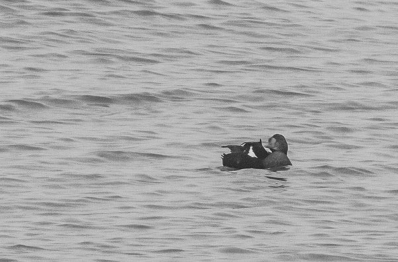Wayne R. Petersen

David M. Larson
Regular readers of Bird Observer may recall that the October issue’s mystery bird was a waterfowl, a female Common Eider. For December I am once again featuring a duck, a fact that I am readily disclosing because unlike the duck in the last issue, its features are unambiguous. The combination of its chunky shape, relatively flat and round-tipped bill shape, and prominent white on the wing remove all other species except possibly a Black Guillemot, which would show a sharp pointed bill and noticeably less blocky shape. No, this is a real duck!
Knowing that the bird has white on the wings narrows the field somewhat, but unfortunately a number of waterfowl species have white patches somewhere on their wings. Few ducks, however, are as blocky-looking as the mystery duck. In fact, the only ducks that typically exhibit the heavy-bodied look of the pictured species are sea ducks. Most sea ducks are among the largest ducks regularly seen in Massachusetts—the Harlequin Duck is an exception—and all of them except the Black Scoter have white somewhere in their plumage. On this duck, the white appears to be on the wing, but because of the way the wing is held, the precise location of the white is not entirely obvious.
A closer look at the mystery duck reveals a fairly short bill that is clearly rounded at the tip. The bill also has a conspicuous broad lobe extending up onto its face. A colored view of the duck on the Bird Observer website indicates that the bill is distinctly pinkish-orange. The bird also shows a somewhat mottled and slightly paler color to the chest than to the rest of the otherwise black body plumage. When the rounded head profile is combined with the distinctive bill shape and color, the bird can only be a King Eider (Somateria spectabilis). The white patch showing on the wing is located on the upper wingcoverts, but its precise position is not obvious because of the way the wing is held. The chest is contrastingly lighter brown than the black of the rest of the body and the head appears chocolate brown, which indicates that the mystery bird is an adult male in eclipse plumage. Massachusetts observers seldom get to see King Eiders in this plumage, yet when the combination of features exhibited by the mystery duck are taken together, its identification becomes straightforward.
King Eiders are uncommon winter visitors in Massachusetts, where they often consort with flocks of Common Eiders or scoters. They prefer rocky coastlines, so are most frequent along the coast of Cape Ann or similar sites along the South Shore. Sometimes seen passing headlands with flocks of other migrating sea ducks in fall, they are also rarely encountered as nonbreeding summer visitors. David Larson photographed this King Eider in Barrow, Alaska, in October 2016.
Wayne R. Petersen